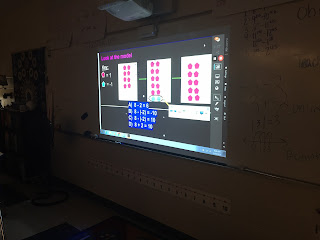Snowflake Ceiling Decorations
We were ending our rational number unit right before Thanksgiving break, and we decided we needed some snowflakes to return to. Students were working on ordering fractions, decimals, and percents so they created paper chains out of the problems that they ordered and then added their own snowflake design to the end. It was simple, yet made our room quite festive!Math Vocabulary Ornaments
Vocabulary instruction is a huge initiative at our school, so we decided to have our students make ornaments that represented math vocabulary words. We added a writing portion as well to include literacy. Students were give a rubric, and were able to choose a word from a list. In order to have a variety, students in the same class could not choose the same word. Once students completed their ornament, they showed them to me and then were able to choose one of the trees in our classroom to hang it on.
This could easily be adapted to work with any content's vocabulary. Below is a google doc link to the rubric. I've also added it to the ClassFlow Marketplace for free, check it out here.

Some Examples:
Elf Equations
Another thing we like to do is watch the movie, Elf, which is my all time favorite Christmas movie ( and seems to be the majority of my students' as well). In order to watch a movie at my school, we have to incorporate our content objectives.
I created an Elf Equations activity with questions dealing with our current unit (translating, modeling and solving equations) to go along with the movie. In the past, I've always printed copies for each student. Our copier was broken the day I went to make copies, which gave me the idea to make it a paperless activity! I added the questions into ClassFlow using the assessment builder, and then added the assessment into an assignment so that students could work at their own pace, and if they didn't finish during class they could finish at home. I added the assessment into the ClassFlow Marketplace, check it out here.
As always, I'm continually looking for suggestions and/or feedback! How do you incorporate Christmas and other holidays into your classroom/curriculum?
































